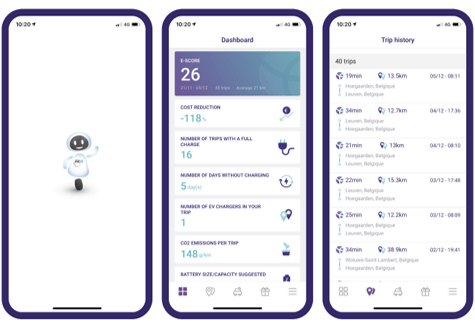
Further, Faster, Cheaper: How Data Analytics Helps Mobility Businesses Go an Extra Mile
A practical guide for mobility businesses on how to make the most out of their data and build data-centric solutions. … Read More
In any business, those who can predict the future and adapt to coming changes have the least downtime and waste, which greatly impacts the bottom line. Conversely, companies unprepared or resistant to transformation have had huge setbacks or even gone out of business throughout history. When we consider the fleet management industry, this is no different. Is now the time to leap into electric vehicles? What about autonomous cars? Fleet management data analytics can help you decide if and how to integrate EVs and AVs.
As electric vehicles are becoming more popular, fleet managers are increasingly wary of their impact on fleet composition, infrastructure, and ultimately—spending and revenue. Coupled with the rise of autonomous vehicle technology lately, the future of the fleet management industry has probably never looked so different. While some developments within the EV and AV area still need some time to mature, others are already at our fingertips, ready to be embraced. But using them to a competitive advantage calls for a strategic approach based on data.
Electric vehicles are top of the chart for many fleet managers. They are growing in popularity all over the globe. In 2020, more than 10 million electric cars were traversing the world’s roads. One year later, their sales skyrocketed by 26%, topping 6.4 million units sold. Today’s businesses operating vehicles commit to EVs to keep up with this consumer trend.
EVs may seem like an obvious choice, considering their potential to decrease emissions and lower fuel and maintenance costs. Going electric isn’t just as easy as flipping a switch, though. As more and more regulations promoting electric mobility come into force, embracing sustainable mobility seems like a non-negotiable rather than an option. But planning and implementation are always the hard part. The required infrastructure may seem overwhelming, but given enough time and effort, it’s possible to build an efficient strategy that will bring sizeable revenue in the long term.
Electric Light Commercial Vehicle Registration by Region 2015-2020
Source: IEA, Electric LCVs registrations by region, 2015-2020, IEA, Paris
https://www.iea.org/data-and-statistics/charts/electric-lcvs-registrations-by-region-2015-2020
One of the top challenges faced by fleet managers is ensuring optimized charging infrastructure to fulfill the needs of EVs in their fleets. Buying the vehicles is a minor issue compared to what follows the purchase.
Electric cars require charging outlets, and the time of charging is much greater than the amount of time needed to refuel a vehicle with a gasoline or diesel engine. The driver can’t pull up to a refueling station and fill up the car in a few minutes, and a technician can’t drive around a lot with a fuel truck topping off vehicles for the next day. To effectively manage EV fleet activity, charging stations must be built, and with the increase of charge times, charging would almost need to be part of regular maintenance.
Regarding maintenance, technicians should have less work, lowering the overhead cost per vehicle, with less moving and serviceable parts on an electric car, right? But with battery replacement concerns, the cost of infrastructure, and the hassle of charging times, companies might ask themselves, is it worth it?
Another question that remains unresolved concerns autonomous cars. While we may still be some time away from fully autonomous self-driving vehicles, or level 5 as the Society of Automotive Engineers call it, being integrated into the fleet, they will be here one day. In the not too distant future, the fleet management team will need to address that. Currently, level 4 vehicles are being tested and will likely grow in popularity in the coming years. For the time being, these vehicles need to have a driver available to handle some tasks, like backing into a loading dock and finding parking spots. But with considerably less time required to have hands on the wheel, the integration of the “mind off” vehicles might change the makeup of the fleet of drivers drastically.
Delivery vehicles might be the new cubicle for jobs that can be done with breaks in between. For example, customer service representatives and entry-level salespeople might be better suited for the business to double as delivery personnel. As they are traveling between locations, they can handle phone calls and emails, and when the need arises, take over as temporary delivery specialists. In many industries, the sales forces visit the clients and customers, so if they can do most of their work on the way, production loss on that end will be very minimal. Such an approach could even increase productivity, depending on the amount of time the sales force spends on the road. While the above vision may seem far-fetched to many, it wouldn’t be the first case of the unimaginable coming true if it materializes.
Thankfully, technology is improving everywhere, not just in vehicles. Optimizing the makeup of your fleet is about making well-informed decisions about which vehicles can be transitioned from combustion engines, whether diesel or gasoline, to another energy source. Data-driven fleet optimization analytics systems assist operators in many facets of fleet management, including tracking information that will help enhance fleet composition in the future.
AI-driven predictive platforms process individual drivers’ mobility patterns to calculate accurate eco and EV transition profiles. First, they integrate with trip detection software installed on mobile devices, or other solutions like OBD dongles, blackboxes, or car data platforms, and pull information about a particular driver, such as typical routes they drive, duration of trips, where they stop, duration of stops, driving style, and availability of charging infrastructure. Next, they develop an objective assessment of a driver’s suitability to move to an electric car based on all these factors.
Using data-driven fleet management, managers can review the information provided and decide what would be the ideal fleet makeup from now on. Then, they can add a combination of full-electric, plugin-hybrid, and hybrid vehicles to balance out their fleet’s needs. Taking the guesswork (or the tons of labor required to analyze the information manually) out of fleet management analytics will simplify and enhance decision-making, helping fleet managers become more efficient with new vehicle choices. And more accurate, data-backed decisions will take away, or at least reduce, the fear of having a fleet that cannot cover all the business’s needs and a fleet that is wasting fuel and money.

An example of a mobile app using a predictive model that indicates the potential to switch to electric vehicles for a given profile.
Source: AskLee EV-Assessment Mobile App
https://asklee.be/
Fleet managers have plenty to keep them busy with all these innovations coming. A change will be essential to excel in the future, and for many, it will be necessary to survive. That doesn’t necessarily call for an abrupt and dramatic revolution. However, increasing the number of electric vehicles and preparing for a semi-autonomous fleet should be discussed in meetings sooner rather than later. Some companies have already started optimizing their fleets by adding EVs to get a head start. Many more are planning to follow soon. Autonomous vehicles are still in development, but plans and policies should be in place on handling them before they get here.
Key Takeaway: Data-driven fleet management analytics and fleet optimization analytics empower fleet managers to better evaluate risks and opportunities related to disruptions like EVs and AVs. But, likely, their jobs won’t become easier. On the contrary, to efficiently manage the fleets of the future, operators will need to upskill on breakthrough technologies, like data analytics, artificial intelligence, and mobile telematics, and understand how to use them. As technology-induced shifts are underway, making sure your business and team are ready to harness them is now more important than ever. Be proactive and get on board with fleet optimization technology now!

A practical guide for mobility businesses on how to make the most out of their data and build data-centric solutions. … Read More

Motion-S, the Luxembourg-based data-driven mobility analytics company, announced today that the board decided to strengthen the company’s focus on mobility data analytics solutions. New solutions based on OEM-connected car data will be a centerpiece of the company’s offer. Motion-S will continue to expand its business activities related to its white-labeled insurance telematics platform and fleet optimization API that covers safe and sustainable driving and predictive vehicle wear analytics.
To drive the company to the next level, the board of directors further decided on a change in the company’s management. As of March 01st, 2023, Andres Petrillo will take over the position of CEO from German Castignani, co-founder of the company. The board thanks German for his outstanding engagement in leading the company successfully during the past three years as a CEO. German will continue to support the company’s growth as an advisor to Motion-S and will remain a shareholder of the company.
… Read More

Remember the early days of the pandemic? Cities became ghost towns, and public spaces were no longer public, as everyone locked in to avoid getting infected. COVID has affected most aspects of our lives, and mobility was no different. With work and school going remote and traveling severely limited or outright prohibited, roads emptied. As a result, traffic remained light—even though driving was the only way to get a little taste of the outside world for many. … Read More
We are happy to welcome you to our community! LIGHT PROTECTION POLICY Accidents with third parties Damage to third-party propertyTheft & VandalismFire & Natural disasters Animal damagesCivil disturbanceRoadside assistance Period:

The invention of the gas-powered car by Carl Benz in 1885 wasn’t just another step in the history of mobility—this time, humanity has made a real leap forward. By making transportation more efficient and accessible, internal combustion engine (ICE) vehicles have affected all industries in one way or another. Over time, we started to rely on them so heavily that we now design our routines, lifestyles, and even entire cities around them.
But no king rules forever. Fast-forward to today, and after almost 130 years, the reign of combustion engine cars is slowly but surely coming to an end. A new contender is on the rise—electric vehicles (EVs). … Read More

According to various sources, a new car loses 9–11% of its value the moment you drive off the dealer’s lot. Over 2-3 years, its price may diminish by more than a half! Although it might seem that the situation is helpless, data science can provide a cure. Learn how applying the right algorithms on telematics data can help you protect and boost the value of your vehicles.
… Read More
| Cookie | Duration | Description |
|---|---|---|
| cookielawinfo-checkbox-analytics | 11 months | This cookie is set by GDPR Cookie Consent plugin. The cookie is used to store the user consent for the cookies in the category "Analytics". |
| cookielawinfo-checkbox-functional | 11 months | The cookie is set by GDPR cookie consent to record the user consent for the cookies in the category "Functional". |
| cookielawinfo-checkbox-necessary | 11 months | This cookie is set by GDPR Cookie Consent plugin. The cookies is used to store the user consent for the cookies in the category "Necessary". |
| cookielawinfo-checkbox-others | 11 months | This cookie is set by GDPR Cookie Consent plugin. The cookie is used to store the user consent for the cookies in the category "Other. |
| cookielawinfo-checkbox-performance | 11 months | This cookie is set by GDPR Cookie Consent plugin. The cookie is used to store the user consent for the cookies in the category "Performance". |
| viewed_cookie_policy | 11 months | The cookie is set by the GDPR Cookie Consent plugin and is used to store whether or not user has consented to the use of cookies. It does not store any personal data. |
Test drive our API Suite for 30 days!
Tell us a bit about yourself, and we’ll get in touch with you in no time.